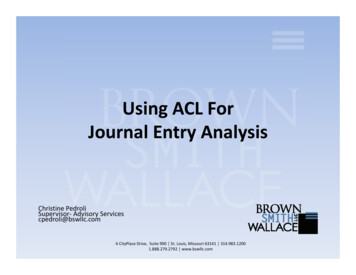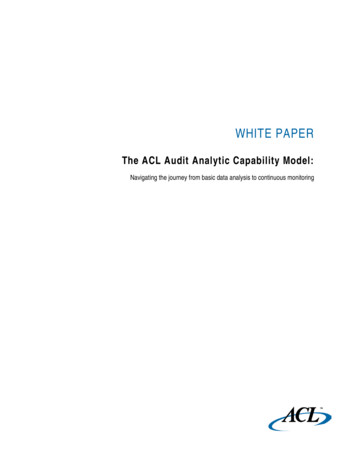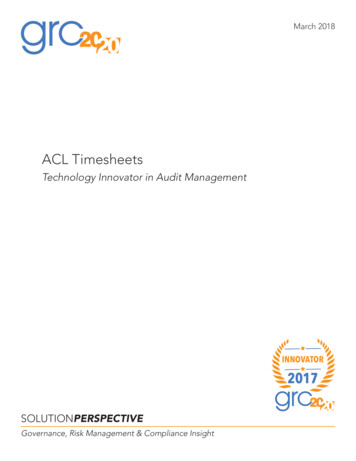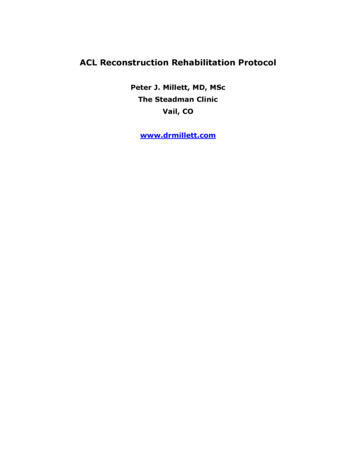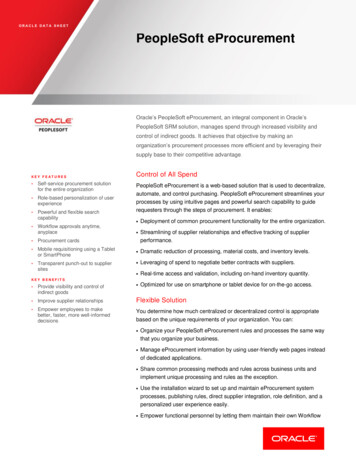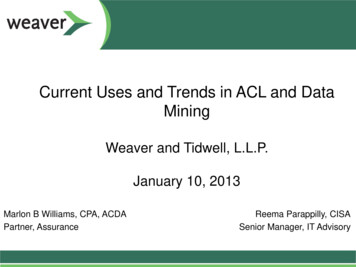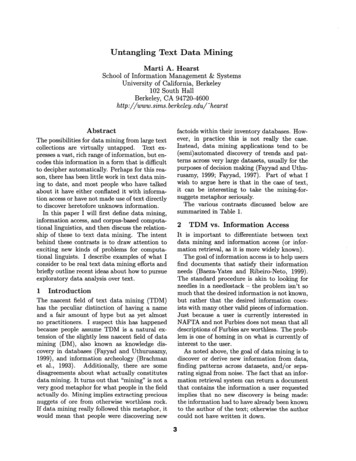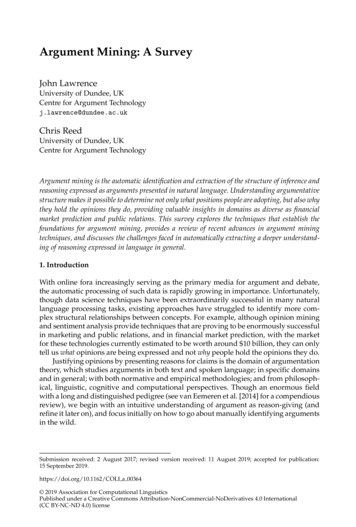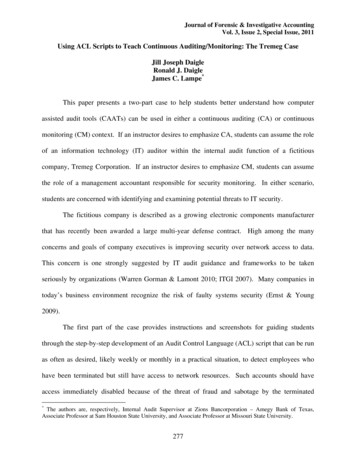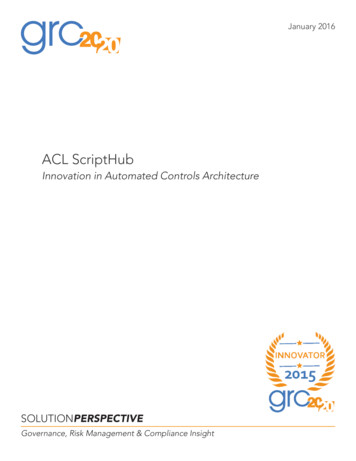
Transcription
January 2016ACL ScriptHubInnovation in Automated Controls ArchitectureSOLUTIONPERSPECTIVEGovernance, Risk Management & Compliance Insight
2016 GRC 20/20 Research, LLC. All Rights Reserved.No part of this publication may be reproduced, adapted, stored in a retrieval system or transmitted in any formby any means, electronic, mechanical, photocopying, recording or otherwise, without the prior permission ofGRC 20/20 Research, LLC. If you are authorized to access this publication, your use of it is subject to the UsageGuidelines established in client contract.The information contained in this publication is believed to be accurate and has been obtained from sourcesbelieved to be reliable but cannot be guaranteed and is subject to change. GRC 20/20 accepts no liabilitywhatever for actions taken based on information that may subsequently prove to be incorrect or errors inanalysis. This research contains opinions of GRC 20/20 analysts and should not be construed as statementsof fact. GRC 20/20 disclaims all warranties as to the accuracy, completeness or adequacy of such informationand shall have no liability for errors, omissions or inadequacies in such information. Although GRC 20/20 mayinclude a discussion of related legal issues, GRC 20/20 does not provide legal advice or services and its researchshould not be construed or used as such. 2016 GRC 20/20 Research, LLC; Resdistribution License Granted to ACL Services2
Table of ContentsChallenged to Provide Assurance in a Dynamic Environment. 4Why Not See BOTH the Forest and the Trees of Risk? .5Delivering 360 Contextual Awareness of Risk & Performance.6ACL ScriptHub. 7Innovation in Automated Controls Architecture.7What the ScriptHub Innovation Is About .7How is the ScriptHub Innovation Different?.7Benefits of ScriptHub .8Considerations in Context of ScriptHub.9About GRC 20/20 Research, LLC. 10Research Methodology. 10TALK TO US . . .We look forward to hearing from you and learning what you think about GRC 20/20research. GRC 20/20 is eager to answer inquiries from organizations looking to improve GRCrelated processes and utilize technology to drive GRC efficiency, effectiveness, and agility. 2016 GRC 20/20 Research, LLC; Resdistribution License Granted to ACL Services3
ACL ScriptHubInnovation in Automated Controls ArchitectureChallenged to Provide Assurance in a Dynamic EnvironmentOrganizations are in a constant state of flux as they manage operations and have a rangeof technologies to support business processes and transactions. Distributed businessoperations and technology are growing and changing at a rapid pace. At the same time,organizations attempt to remain competitive with shifting strategy, technology, andprocesses while keeping current with changes to risk and regulatory environments aroundthe world. The multiplicity of environments that organizations have to monitor andprovide assurance for are growing more complex and constantly evolving.This is further challenged by the explosion of data in organizations that has broughton the era of “Big Data,” and with that we now have “Big GRC Data.” Governance,risk management, and compliance (GRC) professionals are attempting to manage highvolumes of structured and unstructured data across multiple systems and processesto see the big picture of performance and risk, while providing assurance to theorganization. The velocity, variety, and volume of data are overwhelming – disruptingGRC assurance activities, often slowing them down at a time when they need to be agileand fast.As a result of these challenges, GRC oversight requires greater insight into businesssystems and transactions and in a way that is efficient, effective, and agile. Relying onERP expert consultants that understand the cryptic world of ERP configuration andadministration slows assurance activities down and costs more money.The decentralized, disconnected, and distributed business systems and data catch theorganization off guard to risk and exposure. Complexity of business and intricacy andinterconnectedness of data requires that we have an integrated approach to provideassurance in systems, processes, and data.In 1996, Fritjof Capra made an insightful observation on living organisms and ecosystemsthat rings true when applied to GRC and broader business today:The more we study the major problems of our time, the more we come to realizethat they cannot be understood in isolation. They are systemic problems, whichmeans that they are interconnected and interdependent.11Fritjof Capra, The Web of Life: A New Scientific Understanding of Living Systems (New York: AnchorBooks, 1996), 3. 2016 GRC 20/20 Research, LLC; Resdistribution License Granted to ACL Services4
Capra’s point is that biological ecosystems are complex and interconnected and requirea holistic understanding of the intricacy in interrelationship as an integrated wholerather than a dissociated collection of parts. Change in one segment of the ecosystemhas cascading effects and impacts to the entire ecosystem. This is true in providingassurance of business processes and data. Dissociated data, systems, and processesleave the organization with fragments of truth that fail to see the big picture of risk andassurance across the enterprise.What further complicates this is the exponential effect of risk on the business. Businessoperates in a world of chaos. Applying chaos theory to risk is like the ‘butterfly effect’,in which a small event actually results, develops, and influences what ends up being asignificant event. The concept uses the analogy that the simple flutters of a butterfly’swings create tiny changes in the atmosphere that ultimately impacts the developmentand path of a hurricane. Understanding assurance in context of exposure to risk inbusiness systems, transactions, and processes is not a trivial or linear process. To trulycomprehend risk and assurance requires the gathering and analysis of many data pointsacross multiple systems.Why Not See BOTH the Forest and the Trees of Risk?Assurance is not optional. The primary directive of a mature GRC program is to provideassurance to the organization while being effective, efficient, and agile to a dynamicbusiness. This requires a strategic approach that can monitor the business processes,transactions, and information to enable transparency, assurance, and control across theecosystem of the organization’s financial and operational activities. Doing this is not easybecause the organization’s systems, processes, and data are complex and changing.Data analytics should increase the organization’s ability to connect, understand, analyze,and monitor interrelationships and underlying patterns of performance and risk of theorganization. Various business data and processes interrelate in apparent and not soapparent interactions that can surprise the organization and catch it off guard. When riskand control is understood and compartmentalized in silos, the organization fails to seethe web of risk interconnectedness and its impact on performance and strategy leadingto greater exposure than any individual silo understood.To maintain integrity and execute on strategy, the organization has to be able to see theindividual area of risk and control (the tree) as well as the interconnectedness of risks andcontrols (the forest). Risk and performance relationships are non-linear. They are not asimple equation of 1 1 2. They are a mesh of exponential relationships and impactin which 1 1 3, 30, or 300. What seems like a small disruption or risk exposure mayhave a massive effect or no effect at all. In a linear system, effect is proportional withcause; in the non-linear world of business it is exponential. Business and risk is chaostheory realized. The small flutter of risk can bring down the organization. If we fail tosee the interconnections of risk on the non-linear world of business, the result is oftenexponential or unpredictable. 2016 GRC 20/20 Research, LLC; Resdistribution License Granted to ACL Services5
Delivering 360 Contextual Awareness of Risk & PerformanceOrganizations need a data analytics architecture that provides assurance on an arrayof business applications and data to achieve efficiency, effectiveness, and agility in adynamic and distributed environment. This should provide real-time assurance intofinancial transactions, operational assurance, and monitoring in the context of risk andperformance. This is best done as non-invasively as possible. Data analytics need tointegrate with a range of applications and interface and share data between them toprovide holistic awareness of risk and performance so the organization gains a completeview of what is happening: this is what GRC 20/20 refers to as 360 contextual awareness,where risk and performance is monitored and understood in the course of operations,changing risks and regulations, and interactions. Delivery of contextual awarenessrequires that GRC programs have an analytics and intelligence capability that providesa central nervous system to capture signals found in business processes, data, andtransactions as well as changing risks for interpretation, analysis, and holistic awareness ofrisk in the context of the organization.To deliver on this vision requires an integrated view of business information and metricsacross systems, processes, and data. The challenge is, how do GRC teams:nn Find the right source of data. Source information is buried across paper trails,processes, and systems. Reporting and situational awareness require that theorganization have visibility into risk and performance data and metrics, and theirinterrelationships, which is scattered in different areas.nn Transform business data into risk intelligence. Each silo of data brings a piece ofthe picture or a partial version of the truth. These are elements, but they do nottell the full story. In fact, relying on only a partial view of data may be misleading.Bringing data together requires that the organization have consistent and qualitydata to work with and analyze. With reliable data the organization can turn datainto information that drives risk intelligence.nn Understand real-time situational awareness. To deliver a holistic view of GRCinformation and 360 contextual awareness of risk and performance requires thatthe organization get to the source of the information rapidly. GRC teams have tobe able to present accurate information to the right people at the right time. Todo this, data needs to be accessible as well as accurate.Designing an approach to data analytics requires that the organization address thecritical question: How does the organization aggregate, analyze, and report ondistributed data?The Bottom Line: GRC teams need complete situational and holistic awareness ofbusiness performance, risk, and data to see the big picture of risk and its impact onperformance and strategy to provide assurance to the organization and its stakeholders.Distributed, dynamic, and disrupted business requires the organization to take a strategicapproach to data analytics. Achieving a 360 contextual awareness of performance andrisk is about understanding interactions and relationships of cause and effect across 2016 GRC 20/20 Research, LLC; Resdistribution License Granted to ACL Services6
strategy, process, transactions, information, and technology supporting the business andrequires an agile approach to data analytics.ACL ScriptHubInnovation in Automated Controls ArchitectureACL ScriptHub is a GRC solution that GRC 20/20 has researched, evaluated, andreviewed with organizations that are using it in dynamic business environments. GRC20/20 has evaluated and verified the innovation found in ScriptHub, which uses prewritten data analysis scripts like Lego blocks to build tests. This delivers an automatedcontrols architecture to continuously monitor or use on an as-needed basis to provideassurance of business processes and transactions. ScriptHub makes organizations moreefficient, effective, and agile in their GRC processes. In this context, GRC 20/20 hasrecognized ACL ScriptHub with a 2015 GRC Innovation Award for technical innovation inAutomated Controls Architecture.What the ScriptHub Innovation Is AboutThrough a combination of software with an integrated library of content (accumulatingover 28 years of experience), ACL provides solutions that enable audit, compliance, andrisk management professionals to identify and mitigate risk, protect company profits, andimprove business performance.Their latest innovation in this area is ScriptHub. Using ACL Analytics and AnalyticsExchange, ACL Direct Link for SAP , and ScriptHub organizations can seamlesslyaccess and analyze various systems and modules to enable analytics. What would havecost customers thousands of dollars in consulting fees is now written in plain Englishand available at no extra cost as part of an ACL Analytics and Analytics Exchangesubscription. ScriptHub provides pre-written data analysis scripts that are freely availableto users of ACL analytics solutions. The concept for this is analogous to Lego buildingblocks, enabling the organization to custom
requires an agile approach to data analytics. ACL ScriptHub Innovation in Automated Controls Architecture ACL ScriptHub is a GRC solution that GRC 20/20 has researched, evaluated, and reviewed with organizations that are using it in dynamic business environments. GRC 20/20 has evaluated and verified the innovation found in ScriptHub, which uses pre- written data analysis scripts like Lego .
